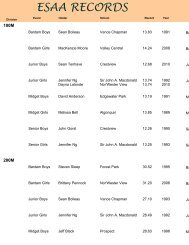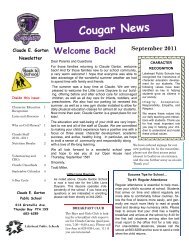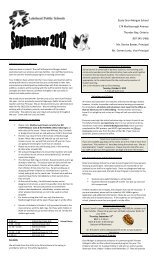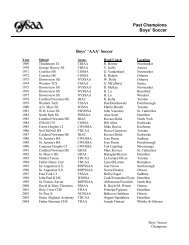Solving Friction Problems 4.3 - Lakehead Public Schools
Solving Friction Problems 4.3 - Lakehead Public Schools
Solving Friction Problems 4.3 - Lakehead Public Schools
Create successful ePaper yourself
Turn your PDF publications into a flip-book with our unique Google optimized e-Paper software.
Tutorial 3 Kinetic <strong>Friction</strong> and Motion<br />
The following Sample <strong>Problems</strong> will help to clarify the effect of kinetic friction on motion.<br />
Sample Problem 1: Stopping a Sliding Box<br />
A 250 kg box slides down a ramp and then across a level fl oor.<br />
The coeffi cient of kinetic friction along the fl oor is 0.20. A person<br />
sees the box moving at 1.0 m/s [left] and pushes on it with a<br />
horizontal force of 140 N [right].<br />
(a) How far does the box travel before coming to rest?<br />
(b) How will the results change if the box is moving right and<br />
the person still pushes right with the same force?<br />
Solution<br />
(a) Given: mK 5 0.20; m 5 250 kg; F ><br />
a 5 140 N 3right4<br />
Required: Dd<br />
Analysis: Draw the FBD of the box (Figure 9). Choose right<br />
and up as positive and left and down as negative. The kinetic<br />
friction must be opposite to the motion. We will fi rst determine<br />
the kinetic friction. We can then use the FBD to fi nd the<br />
acceleration. Once we have the acceleration, we can use one<br />
of the kinematics equations to calculate the distance.<br />
2 2 v2 5 v1 1 2aDd; FK 5 mK FN ; F ><br />
net 5 F ><br />
a 1 F ><br />
K<br />
direction of motion<br />
F N<br />
F g<br />
Sample Problem 2<br />
F a<br />
F K<br />
Figure 9<br />
Two sleds tied together are pulled across an icy surface with<br />
an applied force of 150 N [E] (Figure 10). The mass of sled 1<br />
is 18.0 kg and the mass of sled 2 is 12.0 kg. The coeffi cient of<br />
kinetic friction for each sled is 0.20.<br />
(a) Calculate the acceleration of the sleds.<br />
(b) Determine the magnitude of the tension in the rope between<br />
the sleds.<br />
Figure 10<br />
sled 2<br />
sled 1<br />
150 N [E]<br />
Solution<br />
(a) Both sleds move together with the same acceleration so we<br />
can treat them as one large object. The total mass of the two<br />
sleds is mT 5 18.0 kg 1 12.0 kg 5 30.0 kg.<br />
Solution: F K 5 m KF N<br />
5 m Kmg<br />
5 10.202 1250 kg2 19.8 m/s 2 2<br />
5 490 N<br />
Now calculate the acceleration.<br />
F ><br />
net 5 F ><br />
a 1 F ><br />
K<br />
ma 5 140 N 1 490 N<br />
1250 kg2a 5 630 N<br />
a 5 2.52 m/s2 a > 5 2.52 m/s 2 3right4 1one extra digit carried2<br />
Next calculate the distance travelled. Since we do not know<br />
the time, we use the kinematics equation v 2 2 5 v1 2 1 2aDd.<br />
2 2 v2 5 v1 1 2aDd<br />
2 2 v2 2 v1 5 2aDd<br />
Dd 5 v2 2 2 2 v1 2a<br />
Dd 5 02 2 121.0 m/s2 2<br />
212.52 m/s 2 2<br />
Dd 5 20.20 m<br />
Statement: The box moves 0.20 m before coming to rest.<br />
(b) In this situation, friction is directed toward the left. Since the<br />
applied force acts in the opposite direction, the net force will<br />
be smaller. So the acceleration will now also be smaller, and<br />
the box will travel farther before coming to rest.<br />
There is no need to consider the tension at this point<br />
because it is an internal force and does not contribute to the<br />
acceleration of the total mass.<br />
Draw the FBD of the two sleds (Figure 11). Choose east and<br />
up as positive and west and down as negative.<br />
Figure 11<br />
F N<br />
F K<br />
150 N [E]<br />
F g<br />
Given: m K 5 0.20; m T 5 30.0 kg; F ><br />
a 5 150 N 3E4<br />
176 Chapter 4 • Applications of Forces NEL

















